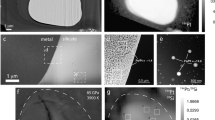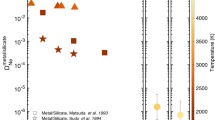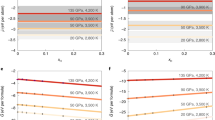Abstract
THE apparent excess of siderophile (iron-Ioving) elements in the Earth's mantle has been a long-standing enigma in the geochemistry of mantle–core differentiation1,2. Although current models have proved successful in explaining some aspects of this problem3–7, important questions remain. In particular, the mantle's near-chondritic ratio of nickel to cobalt (close to that expected for the material from which the Earth formed) is hard to explain, given the markedly different ambient-pressure partitioning behaviour of these elements between iron-alloy and silicate melts3–8. Here we report experimental results which show that both elements become less siderophile with pressure, but the effect is much more pronounced for Ni, so that the partition coefficients of the two elements become essentially equivalent at an extrapolated pressure of ∼28 GPa. The absolute and relative abundances of Ni and Co in the mantle are therefore consistent with alloy–silicate chemical equilibrium at high pressure, indicating that core formation may have taken place in a magma ocean with a depth of 750–1,100 km. We also find that, unlike Ni and Co, sulphur becomes more siderophile with pressure. Sulphur's increased affinity for iron with depth could make it the dominant light element in the Earth's core.
This is a preview of subscription content, access via your institution
Access options
Subscribe to this journal
Receive 51 print issues and online access
$199.00 per year
only $3.90 per issue
Buy this article
- Purchase on Springer Link
- Instant access to full article PDF
Prices may be subject to local taxes which are calculated during checkout
Similar content being viewed by others
References
Ringwood, A. E. Geochim. cosmochim. Acta 30, 41–104 (1966).
Jagoutz, E. et al. Proc. Lunar planet. Sci. Conf. 10, 2031–2050 (1979).
Wänke, H. Phil. Trans. R. Soc. Lond. A 303, 287 (1981).
Brett, R. Geochim. cosmochim. Acta 48, 1183–1188 (1984).
Jones, J. H. & Drake, M. J. Nature 322, 221–228 (1986).
Newsom, H. E. in Origin of the Earth (eds Newsom, H. E. & Jones, J. H.) 273–288 (Oxford Univ. Press, New York, 1989).
Murthy, R. V. Science 253, 303–306 (1991).
Schmitt, W., Palme, H. & Wänke, H. Geochim. cosmochim. Acta 53, 173–185 (1989).
Brett, R. Geochim. cosmochim. Acta 35, 203–221 (1971).
Walker, D., Norby, L. & Jones, J. H. Science 262, 1858–1860 (1994).
Hillgren, V. J., Drake, M. J. & Rubie, D. C. Science 264, 1442–1445 (1994).
Thibault, Y. & Walter, M. J. Geochim. Cosmochim. Acta 59, 991–1002 (1995).
Agee, C. B. et al. J. geophys. Res. 100, 17725–17740 (1995).
Drake, M. J., Newsom, H. E. & Capobianco, C. J. Geochim. cosmochim. Acta 53, 2101–2111 (1989).
Capobianco, C. J. & Amelin, A. A. Geochim. cosmochim. Acta 58, 125–140 (1994).
Dingwell, D. B., O'Neill, H. St C., Ertel, W. & Spettel, B. Geochim. cosmochim. Acta 58, 1967–1974 (1994).
Holzheid, J. R., Borisov, A. & Palme, H. Geochim. cosmochim. Acta 58, 1975–1981 (1994).
Arculus, R. A. Rev. Earth planet. Sci. 13, 75–95 (1985).
Peach, C. L. & Mathez, E. A. Geochim. cosmochim. Acta 57, 3013–3031 (1993).
O'Neill, H. St C. Science 257, 1281–1285 (1992).
Jana, D. & Walker, D. V. M. Goldschimdt Conf. Program and Abstracts 58 (Geochemical Soc., 1995).
McDonough, M. F. & Sun, S.-s. Chem. Geol. 120, 223–253 (1995).
Zhang, J. Z. & Herzberg, C. J. geophys. Res. 99, 17729–17742 (1994).
Kaula, W. M. J. geophys. Res. 84, 999–1008 (1979).
Stevenson, D. J. in Origin of the Earth (eds Newsom, H. E. & Jones, J. H.) 231–249 (Oxford Univ. Press, New York, 1989).
Tonks, W. B. & Melosh, H. J. in Origin of the Earth (eds Newsom, H. E. & Jones, J. H.) 151–174 (Oxford Univ. Press, New York, 1989).
Agee, C. B. & Walker, D. Earth planet. Sci. Lett. 90, 144–156 (1988).
Lorand, J. P. Geochim. Cosmochim. Acta 54, 1487–1492 (1990).
Stosch, H-G. Contr. Miner. Petrol. 78, 166–174 (1981).
Sharma, R. C. & Chang, Y. A. Metall. Trans. B10, 103–108 (1979).
Author information
Authors and Affiliations
Rights and permissions
About this article
Cite this article
Li, J., Agee, C. Geochemistry of mantle–core differentiation at high pressure. Nature 381, 686–689 (1996). https://doi.org/10.1038/381686a0
Received:
Accepted:
Issue Date:
DOI: https://doi.org/10.1038/381686a0
This article is cited by
-
Hadean mantle oxidation inferred from melting of peridotite under lower-mantle conditions
Nature Geoscience (2023)
-
Magma Ocean, Water, and the Early Atmosphere of Venus
Space Science Reviews (2023)
-
The accretion of planet Earth
Nature Reviews Earth & Environment (2022)
-
Chemical analysis of trace elements at the nanoscale in samples recovered from laser-heated diamond anvil cell experiments
Physics and Chemistry of Minerals (2022)
-
Early planetary processes and light elements in iron-dominated cores
Acta Geochimica (2022)
Comments
By submitting a comment you agree to abide by our Terms and Community Guidelines. If you find something abusive or that does not comply with our terms or guidelines please flag it as inappropriate.



